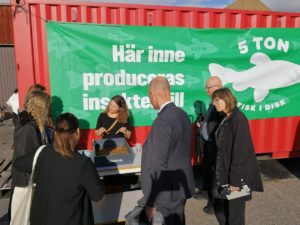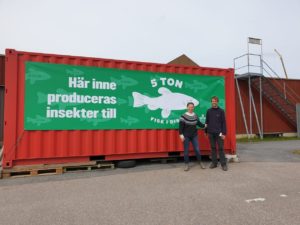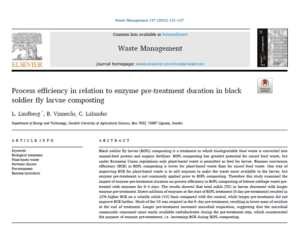This study aimed to enhance the biodegradable solid waste management of low-quality food and agro-industrial waste streams, in terms of BSFL process performance efficiencies by means of co-composting. A fibre-rich, hard to degrade waste stream such as fruit peels by BSFL, was co-composted with a low-quality protein-rich waste stream (fish waste). Results show that co-composting has the ability to increase the BSFL composting efficiencies from nutrient-imbalanced substrates such those used in this study. Protein content increased as more fish waste was added into the substrate mixtures. Biomass conversion rate was generally increased by the addition of fish waste in the substrate mixtures and the highest conversion and BSFL weight achieved was 25 % and 269 mg larva-1, respectively, with 75 % fish waste (12 % protein addition) inclusion. However, BSFL treatment efficiency parameters showed wide variation with inclusion of 75 % fish waste in the substrate, possibly owing to differences in nutritional composition (especially fat content) of different fish waste batches. Lower variations in process efficiency renders higher reliability of the treatment process. Therefore, 25 % inclusion of fish waste (4 % protein addition) was concluded to be beneficial and sufficient enough to improve the overall BSFL process efficiency.
To read more, press here.
Isibika A., Vinnerås B., Kibazohi O., Zurbrügg C. & Lalander C. (2021) Co-composting of banana peel and orange peel waste with fish waste to improve conversion by black soldier fly (Hermetia illucens (L.), Diptera: Stratiomyidae) larvae. Journal of Cleaner Production 318, 128570



 Cecilia Lalander from Kretsloppsteknik welcomed visitors from the Kjell and Märta Beijers Stiftelse at SLU campus in Ultuna. In the spotlight was the latest project “5 ton fish on the counter” (see blogpost from 04. March
Cecilia Lalander from Kretsloppsteknik welcomed visitors from the Kjell and Märta Beijers Stiftelse at SLU campus in Ultuna. In the spotlight was the latest project “5 ton fish on the counter” (see blogpost from 04. March 

 Northern Sweden has recently attracted large industries and server halls as well as the next generation fossil-free steel industry (H2GreenSteel), due to its easy access to renewable energy and natural resources, as well as a cool climate. Boden municipality aims to be Europe’s most resource-efficient and carbon-neutral municipality by 2025. In fact, since 2020, Boden has initiated a large-scale symbiosis project called the
Northern Sweden has recently attracted large industries and server halls as well as the next generation fossil-free steel industry (H2GreenSteel), due to its easy access to renewable energy and natural resources, as well as a cool climate. Boden municipality aims to be Europe’s most resource-efficient and carbon-neutral municipality by 2025. In fact, since 2020, Boden has initiated a large-scale symbiosis project called the  Check out our latest publication in Waste Management
Check out our latest publication in Waste Management